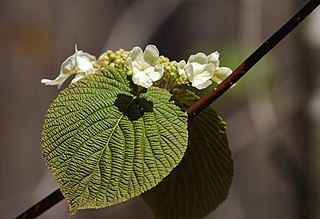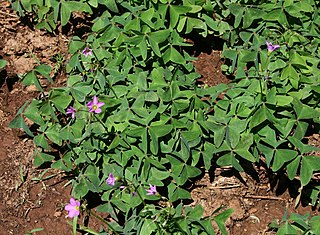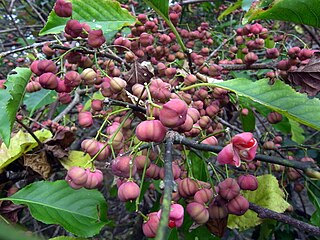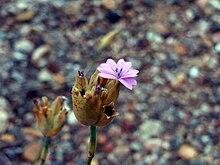
Asphodelus fistulosus is a species of plant known as hollow-stemmed asphodel, onionweed, onion-leafed asphodel, and pink asphodel. It is native to the Mediterranean region. It is an invasive exotic weed in the United States, with significant infestations in California, Arizona, New Mexico, and Texas. It is listed as a Federal Noxious Weed by the United States Department of Agriculture. It is also a common weed in parts of Australia, New Zealand, and Mexico, and it thrives in any area with a Mediterranean climate.

Valeriana rubra, the red valerian, spur valerian, kiss-me-quick, fox's brush, devil's beard or Jupiter's beard, is a popular garden plant grown for its ornamental flowers.

Petrorhagia is a small genus of annual and perennial plants of the family Caryophyllaceae, mostly native to the Mediterranean region. It is low-growing with wiry stems and narrow, grass-like leaves. The flowers are small, in clusters similar to members of the genus Dianthus, in pink, lilac, or white. Petrorhagia saxifraga is the tunic flower or coat flower, similar to baby's breath, but shorter, and used in rock gardens.

Silene dioica, known as red campion and red catchfly, is a herbaceous flowering plant in the family Caryophyllaceae, native to Europe and introduced to the Americas.

Pentaglottis is a monotypic genus of flowering plants in the family Boraginaceae. It is represented by a single species, Pentaglottis sempervirens, commonly known as green alkanet or evergreen bugloss, and it is one of several related plants known as alkanet. It is a bristly, perennial plant native to southwestern Europe, in northwest Iberia and France.

Sagina subulata, the heath pearlwort, Irish-moss, awl-leaf pearlwort or Scottish moss, is a species of flowering plant in the pink and carnation family Caryophyllaceae. It is native to Europe, from Iceland south to Spain, and east to southern Sweden and Romania. It occurs on dry sandy or gravelly soils.

Oenothera suffrutescens is a species of flowering plant in the evening primrose family known as scarlet beeblossom and scarlet gaura.

Viburnum lantanoides is a perennial shrub of the family Adoxaceae, growing 2–4 meters (6–12 ft) high with pendulous branches that take root where they touch the ground. These rooted branches form obstacles which easily trip walkers – hence the common name.

Erica lusitanica is a European species of flowering plant in the family Ericaceae, known by the common names Portuguese heath and Spanish heath.

Erodium cygnorum is a species of herb native to Australia.

Pseudognaphalium luteoalbum, synonyms including Helichrysum luteoalbum, is a species of flowering plant in the family Asteraceae. In the United Kingdom, it is known as the Jersey cudweed.

Coprosma repens is a species of flowering shrub or small tree of the genus Coprosma, in the family Rubiaceae, native to New Zealand. Common names include taupata, tree bedstraw, mirror bush, looking-glass bush, New Zealand laurel and shiny leaf.

Oxalis latifolia is a species of flowering plant in the woodsorrel family known by the common names garden pink-sorrel and broadleaf woodsorrel. It is native to Mexico and parts of Central and South America. However, it has propagated to other parts of the world.

Petrorhagia dubia is a species of flowering plant in the family Caryophyllaceae known by the common name hairy pink. It is native to southern Europe and the Mediterranean Basin, but it is known on other continents, including Australia and North and South America, as an introduced species and sometimes a weed. It is an annual herb growing 25 to 60 centimeters tall, but known to reach 90 centimeters in height. The leaves are up to 6 centimeters long, sheathing the stem at the bases. The inflorescence bears a head-like cluster of flowers, their bases enclosed in a large, expanded mass of wide, claw-tipped bracts. The flower corollas are each further encased in a tubular calyx of sepals. The petals are bright pink to magenta or lavender in color with darker veins. Each is heart-shaped or divided into two lobes at the tip. The fruit is a capsule containing many tiny seeds.

Silene gallica is a species of flowering plant in the family Caryophyllaceae known by several common names, including common catchfly, small-flowered catchfly, and windmill pink. It is native to Eurasia and North Africa, but it can be found throughout much of the temperate world as a common roadside weed.

Spergularia media is a species of flowering plant in the family Caryophyllaceae known by the common names media sandspurry and greater sea-spurrey. It is native to Eurasia and the Mediterranean, where it grows in many types of habitat, including disturbed areas, including places with saline substrates, such as salt marshes and beaches. It is known in many other parts of the world as an introduced species and a common roadside weed. In North America it is a "highway halophyte", often springing up at the margins of roads that are heavily salted in the winter.

Tamarix chinensis is a species of tamarisk known by the common names five-stamen tamarisk and Chinese tamarisk or saltcedar. It is native to China and Korea, and it is known in many other parts of the world as an introduced species and sometimes an invasive noxious weed. It easily inhabits moist habitat with saline soils. It may grow as a tree with a single trunk or as a shrub with several spreading erect branches reaching 6 metres or more in maximum height. It has been known to reach 12 metres. It has reddish, brown, or black bark. The small, multibranched twigs are covered in small lance-shaped, scale-like leaves which are no more than about 3 mm long. The inflorescence is a dense raceme of flowers a few cm long. Each fragrant flower has five petals which are usually pink but range from white to red.

Euonymus hamiltonianus, known by the common names Hamilton's spindletree, Himalayan spindle, and Siebold's spindle is a species of flowering plant in the family Celastraceae. It is native to Asia, where it is distributed in Afghanistan, Russia, China, Japan, Korea, India, Nepal, Pakistan, Bhutan, Thailand, and Myanmar. This is one of the most common Euonymus species. It is cultivated in gardens and landscapes in other parts of the world.

Psammophiliella muralis is a species of flowering plants in the family Caryophyllaceae. It is known as annual gypsophila, cushion baby's-breath and low baby's-breath, an annual plant principally native to Europe except the British Isles. It can be also found in Central Asia, Turkey, the Caucasus, and Siberia. It is one of two species in genus Psammophiliella.

Cerastium diffusum, the fourstamen chickweed or sea mouse-ear, is a species of flowering plant in the pink and carnation family Caryophyllaceae. It is an annual herb, to 30 cm.high, occurring in western Europe and northern Africa. Found mainly in coastal areas of Algeria, the Baleares, Belgium, Corsica, Denmark, France, the Faroe Islands, Germany, Great Britain, Ireland, Italy, Libya, Morocco, Netherlands, Norway, Portugal, Sardinia, Sicily, Spain and Sweden. The flowers have 4, petals, 4 or 5 stamens appearing between March and May. The petals are much shorter than the sepals. The leaves are opposite, (sessile) without petioles and the sepals and bracts are all green, without pale margins. The fruit petioles are erect and diffuse at maturity.



















